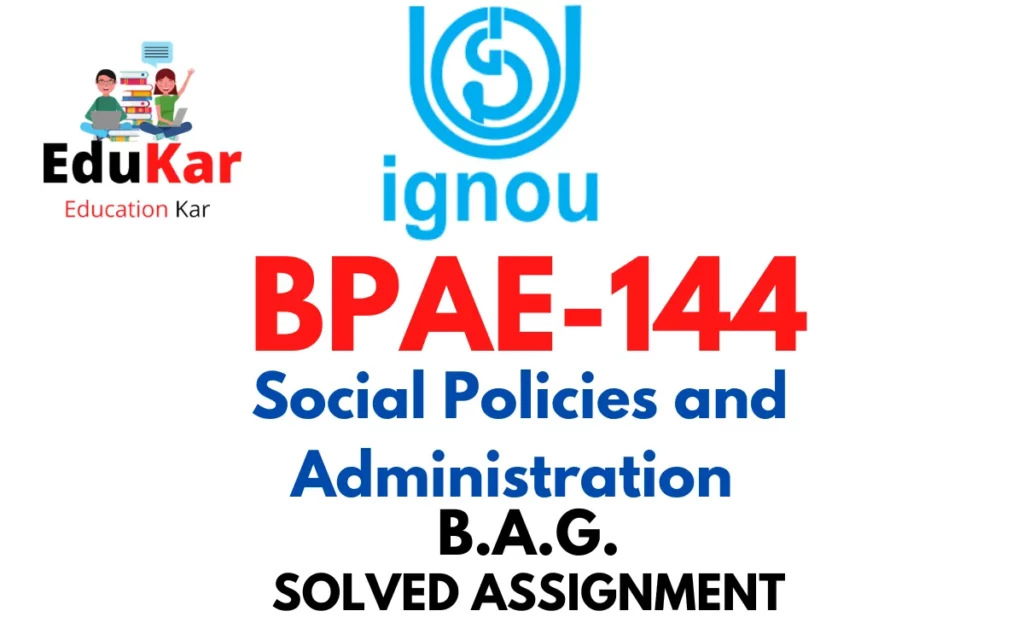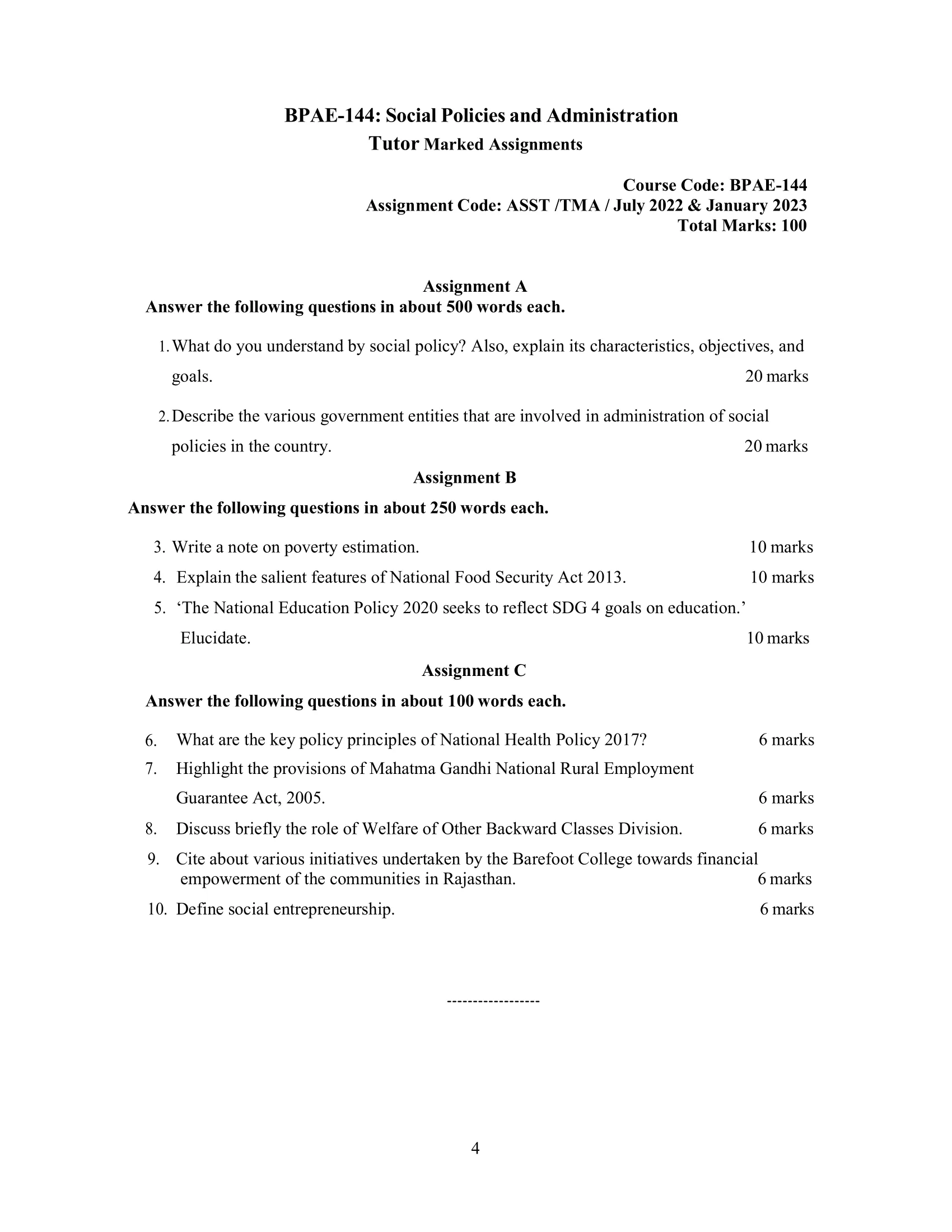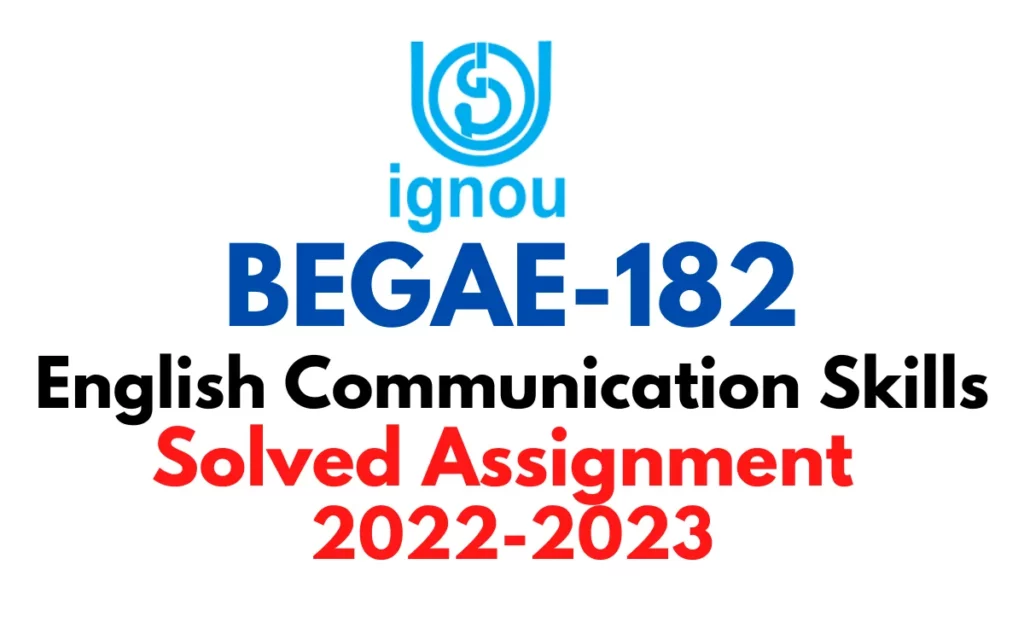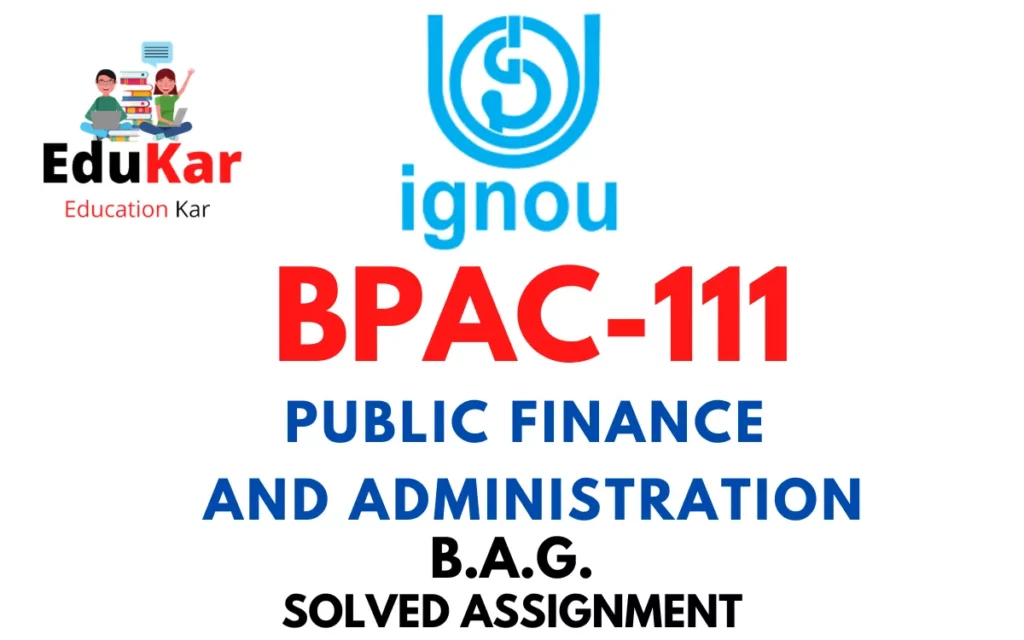Contents
- 1 Assignment A
- 2 Answer the following questions in about 500 words each.
- 3 1.What do you understand by social policy? Also, explain its characteristics, objectives, and goals.
- 4 2. Describe the various government entities that are involved in administration of social policies in the country.
- 5 Assignment B
- 6 Answer the following questions in about 250 words each.
- 7 3. Write a note on poverty estimation.
- 8 4. Explain the salient features of National Food Security Act 2013.
- 9 5. ‘The National Education Policy 2020 seeks to reflect SDG 4 goals on education.’ Elucidate.
- 10 Assignment C
- 11 Answer the following questions in about 100 words each.
- 12 6. What are the key policy principles of National Health Policy 2017?
- 13 7. Highlight the provisions of Mahatma Gandhi National Rural Employment Guarantee Act, 2005.
- 14 8. Discuss briefly the role of Welfare of Other Backward Classes Division.
- 15 9. Cite about various initiatives undertaken by the Barefoot College towards financial empowerment of the communities in Rajasthan.
- 16 10. Define social entrepreneurship.

| Title | BPAE-144: IGNOU BAG Solved Assignment 2022-2023 |
| University | IGNOU |
| Degree | Bachelor Degree Programme |
| Course Code | BPAE-144 |
| Course Name | Social Policies and Administration |
| Programme Name | Bachelor of Arts (General) |
| Programme Code | BAG |
| Total Marks | 100 |
| Year | 2022-2023 |
| Language | English |
| Assignment Code | ASST /TMA / July 2022 & January 2023 |
| Assignment PDF | Click Here |
| Last Date for Submission of Assignment: | For June Examination: 31st April For December Examination: 30th September |

Assignment A
Answer the following questions in about 500 words each.
Ans: Social policy refers to the various interventions, strategies, and initiatives implemented by governments to address social issues and problems within a given society. It encompasses policies, programs, and regulations aimed at promoting social welfare, reducing poverty, and improving the living conditions of individuals and groups.
Social policy has several characteristics that distinguish it from other types of policy. Firstly, it focuses on addressing social issues and problems, such as poverty, inequality, and social exclusion. Secondly, it is typically developed and implemented by governments, although other actors such as civil society organizations and international bodies may also be involved. Thirdly, social policy is often closely linked to broader economic and political objectives, such as promoting economic growth and maintaining political stability. Finally, social policy is generally grounded in values such as social justice, equity, and human rights.
The primary objective of social policy is to promote social welfare, which refers to the well-being of individuals and groups within a given society. This involves ensuring that all members of society have access to the resources and services they need to live fulfilling and dignified lives. Social policy seeks to achieve this objective through a range of goals, including:
- Reducing poverty: Social policy seeks to address poverty by providing income support and promoting access to education, healthcare, and other essential services.
- Promoting social inclusion: Social policy aims to ensure that everyone, regardless of their background or circumstances, is able to participate fully in social, economic, and cultural life.
- Ensuring social protection: Social policy seeks to protect vulnerable individuals and groups from the risks and uncertainties of life, such as unemployment, illness, or disability.
- Addressing inequality: Social policy aims to reduce inequalities between different groups in society, such as those based on income, gender, ethnicity, or geography.
- Fostering social cohesion: Social policy seeks to promote social cohesion and solidarity within society, by fostering a sense of shared values, norms, and goals.
Ans: The administration of social policies in a country involves various government entities that work together to develop and implement policies and programs aimed at promoting social welfare and well-being. These entities may vary from country to country, but there are some common structures and functions that are typically involved. In this answer, I will describe some of the main government entities that are involved in the administration of social policies.
- Ministry or Department of Social Development: This is the primary government entity responsible for the formulation, implementation, and evaluation of social policies and programs. It is usually headed by a cabinet minister and is responsible for coordinating the work of other government agencies and non-governmental organizations (NGOs) in the social development sector.
- Social Security Administration: This entity is responsible for administering social security programs such as old-age pensions, disability benefits, and unemployment insurance. It ensures that eligible individuals receive the benefits they are entitled to and that the programs are administered efficiently and effectively.
- Ministry or Department of Health: This entity is responsible for the development and implementation of health policies and programs aimed at promoting access to quality health care services for all citizens. It is usually headed by a cabinet minister and works closely with other government agencies and health care providers to ensure that health policies are integrated into the broader social policy framework.
- Ministry or Department of Education: This entity is responsible for the development and implementation of education policies and programs aimed at promoting access to quality education for all citizens. It is usually headed by a cabinet minister and works closely with other government agencies and education providers to ensure that education policies are integrated into the broader social policy framework.
- Employment and Labour Department: This entity is responsible for the development and implementation of employment and labor policies and programs aimed at promoting decent work and social protection for all citizens. It is usually headed by a cabinet minister and works closely with other government agencies and employers’ and workers’ organizations to ensure that employment and labor policies are integrated into the broader social policy framework.
- Ministry or Department of Finance: This entity is responsible for the allocation of resources and the management of the national budget. It works closely with other government entities involved in social policy administration to ensure that resources are allocated efficiently and effectively to promote social welfare and well-being.
- National Planning Commission: This entity is responsible for the development of long-term national development plans and the coordination of sectoral plans and programs. It works closely with other government entities involved in social policy administration to ensure that social policies are integrated into the broader national development agenda.
In addition to these entities, there may be other government agencies, such as regional or local government entities, that are involved in the administration of social policies. NGOs, civil society organizations, and international organizations may also play an important role in social policy administration by providing technical assistance, advocacy, and other forms of support. Overall, the effective administration of social policies requires a coordinated effort among all these entities to ensure that policies and programs are effectively implemented to promote social welfare and well-being for all citizens.
Assignment B
Answer the following questions in about 250 words each.
3. Write a note on poverty estimation.
Ans: Poverty estimation is the process of determining the number of people who are living in poverty in a particular region or country. Poverty estimation is a critical tool for policymakers as it helps them to understand the magnitude of poverty, its spatial distribution, and the characteristics of the poor. The estimation of poverty is usually done by calculating poverty indicators, which are measures of the prevalence, depth, and severity of poverty.
The most commonly used poverty indicators are the poverty headcount ratio, poverty gap ratio, and the squared poverty gap. The poverty headcount ratio measures the proportion of the population that is living below the poverty line. The poverty gap ratio measures the average income shortfall of the poor relative to the poverty line, and the squared poverty gap measures the severity of poverty by giving more weight to those who are further below the poverty line.
The estimation of poverty requires accurate and reliable data on household income and expenditure. In most countries, poverty estimation is based on household surveys that collect data on household income and expenditure. The surveys are usually conducted by national statistical agencies or other organizations, such as the World Bank, and are designed to be representative of the population as a whole.
There are several challenges associated with poverty estimation. One of the main challenges is the selection of an appropriate poverty line. The poverty line is the minimum level of income or expenditure required to meet basic needs such as food, shelter, and clothing. The selection of the poverty line is a subjective process and can vary depending on the country and the region.
Another challenge is the accuracy of the data collected through household surveys. In many cases, households may under-report their income or expenditure, which can lead to an underestimate of poverty. In addition, poverty estimation can be affected by changes in the economy, such as inflation or changes in employment patterns.
Despite these challenges, poverty estimation is a critical tool for policymakers as it helps to identify the most vulnerable populations and design targeted policies and programs to reduce poverty and improve living standards.
4. Explain the salient features of National Food Security Act 2013.
Ans: The National Food Security Act (NFSA) was passed by the Indian Parliament in 2013 with the aim of ensuring food security for all citizens of India. The act aims to provide legal entitlements to subsidized food grains to 67% of the population. Here are the salient features of the National Food Security Act 2013:
- Targeted beneficiaries: The act aims to provide food security to around 800 million people in India, including 75% of the rural population and 50% of the urban population. Priority households, including pregnant and lactating women, children between the ages of 6 months and 14 years, and other vulnerable groups, are identified by the state governments for receiving food grains under the act.
- Entitlements under the act: Each person identified as a priority household is entitled to receive 5 kilograms of food grains per month at subsidized rates. The food grains provided under the act include wheat, rice, and coarse grains such as millets.
- Food subsidy: The central government is responsible for providing food grains to the states at subsidized rates, and the state governments are responsible for distributing the food grains to the beneficiaries. The central government bears the cost of food subsidy.
- Grievance redressal mechanism: The act provides for a grievance redressal mechanism to address complaints related to food distribution. A District Grievance Redressal Officer is appointed in each district, and a State Food Commission is established to monitor the implementation of the act and to inquire into complaints and violations of the act.
- Nutritional support: The act provides for nutritional support to pregnant and lactating women and children under the age of six through the provision of free meals and take-home rations.
- Transparency and accountability: The act mandates that the list of beneficiaries is made available to the public, and the state governments are required to conduct periodic social audits to ensure transparency and accountability in the implementation of the act.
The National Food Security Act is a significant step towards ensuring food security and eradicating hunger in India. The act not only provides legal entitlements to food for a large segment of the population, but also aims to improve nutritional outcomes and promote transparency and accountability in the implementation of food distribution programs.
5. ‘The National Education Policy 2020 seeks to reflect SDG 4 goals on education.’ Elucidate.
Ans: The National Education Policy (NEP) 2020 is a comprehensive policy framework that aims to transform the education system in India. The policy is designed to be aligned with the United Nations Sustainable Development Goal (SDG) 4, which aims to ensure inclusive and equitable quality education for all.
The NEP 2020 seeks to reflect the SDG 4 goals on education in several ways:
- Inclusive education: The NEP 2020 emphasizes the need to ensure access to education for all children, including those from disadvantaged communities. The policy aims to provide free and compulsory education to all children from the age of three to 18 years and ensure that children with disabilities have equal access to education.
- Quality education: The NEP 2020 emphasizes the need to improve the quality of education in India. The policy focuses on promoting student-centered and experiential learning, reducing the emphasis on rote learning, and providing access to digital and online resources.
- Lifelong learning: The NEP 2020 recognizes the need for lifelong learning and aims to create a flexible and multi-disciplinary education system that allows individuals to pursue education and training throughout their lives.
- Equity and gender: The NEP 2020 seeks to address issues of gender and social equity in education. The policy aims to eliminate gender, social, and regional disparities in access to education and ensure that all students have access to quality education regardless of their background.
- Teacher development: The NEP 2020 recognizes the critical role of teachers in promoting quality education. The policy aims to provide teachers with high-quality training, continuous professional development, and support to improve their teaching skills and promote innovative teaching practices.
Assignment C
Answer the following questions in about 100 words each.
6. What are the key policy principles of National Health Policy 2017?
Ans: The key policy principles of the National Health Policy 2017 include:
- Ensuring universal access to healthcare services without financial hardship.
- Moving towards a more comprehensive and integrated approach to healthcare delivery.
- Prioritizing the promotion of preventive and promotive health, as well as the provision of quality curative care.
- Increasing the focus on primary healthcare, with an emphasis on strengthening infrastructure and human resources.
- Encouraging the private sector to contribute to healthcare delivery, while ensuring appropriate regulation and oversight.
- Ensuring quality and affordability of essential medicines and medical devices.
- Promoting research and innovation in healthcare to improve health outcomes.
- Strengthening healthcare systems to respond to public health emergencies and disasters.
7. Highlight the provisions of Mahatma Gandhi National Rural Employment Guarantee Act, 2005.
Ans: The Mahatma Gandhi National Rural Employment Guarantee Act (MGNREGA) is a social welfare scheme that was enacted in India in 2005. The key provisions of the Act are as follows:
- Right to work: The Act provides a legal guarantee of 100 days of wage employment to every rural household whose adult members volunteer to do unskilled manual work.
- Employment generation: The Act aims to create durable assets in rural areas by engaging rural workers in a variety of works such as water conservation, drought proofing, afforestation, rural connectivity and sanitation.
- Wage rate: The Act ensures that the wage rate is not less than the minimum wage prescribed by the state government and is linked to the Consumer Price Index for Agricultural Laborers.
- Payment of wages: The Act mandates that wages be paid within 15 days of completion of work and in case of any delay, workers are entitled to compensation.
- Women participation: The Act provides for at least one-third participation of women in the works undertaken.
- Monitoring and accountability: The Act establishes an elaborate system of monitoring and accountability to ensure transparency, accountability, and participation of people in the implementation of the Act.
- Grievance redressal: The Act provides for a robust grievance redressal mechanism for the workers, including the constitution of a Social Audit Committee and an Ombudsman at the district level.
- State-level employment guarantee council: The Act mandates the creation of a state-level employment guarantee council to monitor the implementation of the Act in the state.
The provisions of the MGNREGA aim to create sustainable livelihoods for the rural poor, reduce rural-urban migration and stimulate the rural economy. The Act is one of the most significant and widely implemented social welfare schemes in India and has been successful in providing employment opportunities to millions of rural households across the country.
8. Discuss briefly the role of Welfare of Other Backward Classes Division.
Ans: The Welfare of Other Backward Classes (OBCs) Division is a division within the Ministry of Social Justice and Empowerment in the Government of India. It is responsible for the formulation and implementation of policies and programs for the welfare of Other Backward Classes (OBCs) in India.
The key role of the division is to ensure that the social, educational, and economic status of OBCs is uplifted, and that they are provided with equal opportunities in education, employment, and other areas. The division is also responsible for the implementation of various schemes and programs aimed at the upliftment of OBCs.
The division works in close coordination with the state governments, union territories, and other stakeholders to ensure that the welfare measures are effectively implemented. It also provides financial assistance to the state governments for the implementation of various schemes and programs for the welfare of OBCs.
The division has also been instrumental in conducting various studies and surveys to assess the socio-economic status of OBCs, and to identify areas where intervention is required. It has also been actively involved in conducting awareness campaigns to sensitize people about the issues faced by OBCs and to ensure that their rights are protected.
9. Cite about various initiatives undertaken by the Barefoot College towards financial empowerment of the communities in Rajasthan.
Ans: Barefoot College is a non-governmental organization based in Rajasthan, India that has been working towards the financial empowerment of rural communities for several decades. Here are some of the initiatives undertaken by Barefoot College:
- Solar electrification: Barefoot College has been training rural women in solar electrification and providing them with the skills and equipment to install and maintain solar lighting systems in their villages. This has not only brought light to the villages but has also created job opportunities for women.
- Water harvesting: Barefoot College has been working on water harvesting projects in rural areas to improve access to clean drinking water. The organization has trained local people in water harvesting techniques and helped them to set up water harvesting structures such as ponds, check dams, and recharge wells.
- Livelihood generation: Barefoot College has been working on various initiatives to create livelihood opportunities for rural communities. The organization has provided training in artisanal skills, such as weaving and embroidery, to help people create sustainable livelihoods. They have also set up a rural BPO that provides job opportunities to young people in the villages.
- Education and health: Barefoot College has set up schools and health centers in rural areas to improve access to education and healthcare. The organization has also provided training to local people to become healthcare workers and teachers.
- Financial inclusion: Barefoot College has been working on financial inclusion initiatives to improve access to finance in rural areas. The organization has set up community banks and provided training in financial management and entrepreneurship to help people start their own businesses.
These initiatives have not only brought about significant positive impact in the lives of people in rural communities in Rajasthan, but they have also inspired similar initiatives across the country and globally. The approach of Barefoot College towards empowering communities has been recognized and appreciated globally, and the organization has won several awards for its work.
Ans: Social entrepreneurship is the use of entrepreneurial strategies and principles to create social, cultural, or environmental impact. Social entrepreneurs identify social problems and create innovative solutions that are sustainable and scalable, often using market-based approaches to achieve their objectives. Social entrepreneurship combines the desire to create positive social impact with the entrepreneurial mindset of innovation, risk-taking, and resourcefulness. Social entrepreneurs often create organizations or businesses that operate in areas such as education, healthcare, environment, poverty alleviation, and other social sectors, with the goal of generating positive social impact while also achieving financial sustainability.
How to Download BPAE-144 Solved Assignment?
You can download it from the www.edukar.in, they have a big database for all the IGNOU solved assignments.
Is the BPAE-144 Solved Assignment Free?
Yes this is absolutely free to download the solved assignment from www.edukar.in
What is the last submission date for BPAE-144 Solved Assignment?
For June Examination: 31st April, For December Examination: 30th October


![[Solved Assignment] BPCS 188-APPLICATIONS OF SOCIAL PSYCHOLOGY (IGNOU-BAG) 2022-2023 BPCS 188-APPLICATIONS OF SOCIAL PSYCHOLOGY IGNOU BAG Solved Assignment 2022-2023](https://edukar.in/wp-content/uploads/2023/01/BPCS-188-APPLICATIONS-OF-SOCIAL-PSYCHOLOGY-IGNOU-BAG-Solved-Assignment-2022-2023-1024x640.webp)













